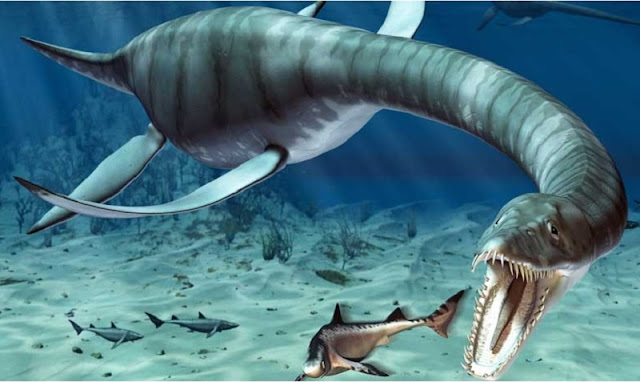Plesiosaurs inhabited the seas from around 200 million to 65 million years ago. They were not dinosaurs, despite living at the same time as dinos. It is thought that plesiosaurs fed mainly on fish, breathed air and laid their eggs on beaches. The largest of these sea monsters reached 15 meters (49 feet) in length.
People have been unearthing fossils of such sea creatures for hundreds of years. But scientists are still finding new species and discovering new information on what these animals looked like and how they lived.
Long-necked beasts
About 205 million years ago, a new type of marine reptile appeared in the seas. Scientists call them plesiosaurs (PLEEZ-see-oh-saurs), from the Greek words for “near to lizards.” The earliest of these resembled lizards, their presumed ancestors. But over time, the animals evolved to look very different.
Plesiosaurs typically had broad bodies, flippers and short tails. The most distinctive species also had long necks that made the animal look like a snake threaded through a turtle's shell. And while most plesiosaurs had long necks, some had really long necks, notes Michael Everhart. He’s a vertebrate paleontologist at Fort Hays State University in Hays, Kansas.
These super-long-necked plesiosaurs belonged to a group called elasmosaurs (Ee-LAZ-moe-saurs). Their necks were so long that some of the first scientists to assemble their fossils couldn’t believe it, says Everhart. They mixed up the long neck and short tail, mistakenly putting the skull at the wrong end.
Plesiosaurs were known for their long necks, but Albertonectes vanderveldei had an exceptionally long one that included 76 neck bones. This marine reptile lived about 70 million years ago, when dinosaurs dominated the land.
Recently, Everhart and his team took another look at fossils from a plesiosaur called Elasmosaurus platyurus. Dug up in Kansas during the late 1860s, these rocks were soon shipped East to a museum in Philadelphia. They’ve been there ever since.
The fossils that Everhart’s group surveyed are amazingly complete. They include a skull, which often is missing from plesiosaur specimens. Few skulls have survived because they are so delicate and relatively small — not much bigger around than the creature’s neck. Scientists have estimated that the creature was about 13 meters (42 feet) long when it was alive. And 7 meters (23 feet) of that length was nothing but neck!
Many teams have studied this specimen since it was first unearthed almost 150 years ago. But scientists are still in debates over the animal’s anatomy. For instance, they can’t decide how many neck bones it had.
When Everhart and his teammates looked at all the fossil pieces sitting on the museum’s shelves, they found an additional bone stored separately on a shelf nearby. It probably had been excavated at the same time. But it hadn't been labelled by the people who dug it up. Still, it seemed to have come from the right type of rock and it had the same color and texture as the other fossils. It also was the right size and shape to be a part of a plesiosaur neck. So the researchers thought that perhaps the ancient jigsaw puzzle hadn’t been put together correctly. After further study, they proposed that this bone was indeed a new addition to the plesiosaur fossil.
If that’s right, then the beast had a whopping 72 bones in its neck. For comparison, almost all mammals — from mice to humans and giraffes — have only seven. Only one vertebrate now known had more neck bones than Elasmosaurus, says Everhart. That creature was also an elasmosaur. Its name is Albertonectes vanderveldei. It lived about 70 million years ago. Overall, it was slightly shorter than Elasmosaurus, but it had 76 neck bones.
Near the other extreme of neck proportions were marine reptiles called pliosaurs (PLY-oh-saurs). They emerged at around the same time as plesiosaurs. Even though they were related, evolution shaped them differently. Both groups both had broad, streamlined bodies. But pliosaurs had relatively short necks and massive heads. Because pliosaurs had large pointy teeth, scientists suggest they ate only meat. Their diet probably included fish, squid and other marine reptiles.
| 


No comments:
Post a Comment